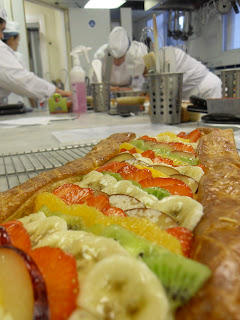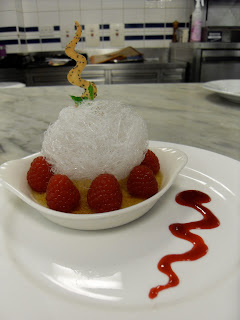Yesterday we had our demonstration and practicals to finish off our creme deserts. In demo we were shown some decorations means and methods such as shaping out tuilles, sugar spinning and piping sauces and choclate using fine paper cone bags. We also had our first fire drill, which happened convieniently whilst I was mid- wee. We filed out like good boys and girls, had our register, and then went back in to see the chef complete her plates and tuck into a mid morning creme brulee.
Poppyseed tuille
Obligatory sugar swan
Spun sugar candy floss
Seven hours and a quick trip to the cinema later we began our wild friday night of shaping, piping and presenting. This is the first time we have had a proper dish to present to the chef to be marked and the only instruction was that our designs must include a tuille. Other than that we had fruit, sugar, chocolate and sauces to play with. At the end of class we took it in turns to present our plates to the chef and get our feedback. And now, here they are for you to pass judgement on:
And the feedback? Okay, here we go:
Creme Caramel: "Good colour, nice custard, well cooked"
Presentation: "Very good, good use of 2 colours and height. Good idea. Need to work on chocolate piping to be finer and smoother" and, I promise, "with work, almost a perfect dish"
Creme Brulee: "Good amount in dish, good glaze, could possibly go a shade darker"
Presentation: "Needs more height. Should make better use of tuille to give height"
Overall, I was pretty pleased. Really need to work on my general neatness and piping, but that was always going to be the case. Excluding the strange anomaly of an A in GCSE art, my creativity is generally blemished by my clumsy disposition. Piping, I have been told, is the crucial difference between a good and a great pastry chef. So, a weekend of piping a plenty.
On the plus side, the desserts definately looked good enough to eat and really were delicious.


















































